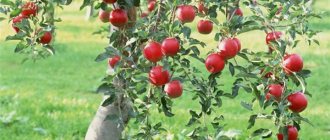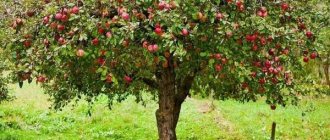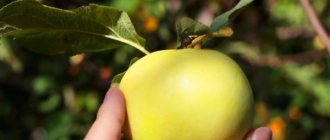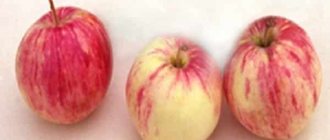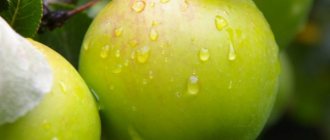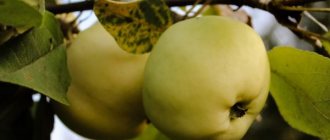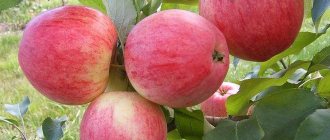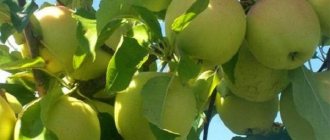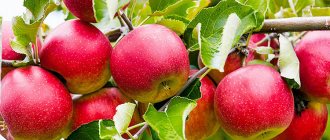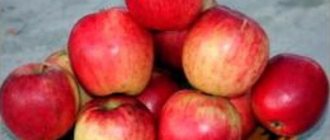A beautiful apple orchard is the pride of any gardener. The trees differ from each other in height, size and shape of the crown, and most importantly, in the taste of the fruit. Many gardeners want to plant a compact, low-growing tree with tasty apples in their garden. Down to earth - an apple tree that has all these advantages. According to many gardeners, it has other qualities that are worthy of the attention of both beginners and experienced gardeners.
Apple tree variety Grounded.
Description, photo
Down to earth is the name of the apple tree, which partially characterizes it. This is a variety of apples with low tree height - the result of the work of a group of specialists (V.I. Putyatin, M.A. Mazunin, N.F. Mazunina) of the South Ural Research Institute of Horticulture and Potato Growing. The variety was obtained by genetic mixing of Vydubetskaya weeping with a complex hybrid 1-63-197.
Advantages and disadvantages
Significant worthy features of the variety can be summarized as follows:
- Genetically determined short stature;
- High yields;
- Short growing season and early pregnancy;
- Excellent frost tolerance.
Among the disadvantages, it is worth highlighting the small fruit and the likelihood of darkening of the pulp during storage of the fruit.
Dimensions of an adult tree
The tree of the Prizemlennoye variety is classified as a natural dwarf ; its height can reach when cultivated:
- On a seed rootstock – 2.5 m ;
- On clonal rootstocks (vegetative) – 1.5-2 m.
The crown is flat-rounded, composed of medium-sized shoots of a greenish-walnut color, extending from the central conductor at a naturally right angle. The leaves are large, shaped like an elongated oval, the edges are finely serrated, the leaf blade is slightly pubescent.
Apple tree Grounded 6 years.
The fruits are medium-sized, round in shape, covered with a dense, glossy, smooth skin of a yellow-green hue, a scarlet blush on top of it . The pulp is white with a light green tint, grainy in texture, dense, crispy, sweet with an unobtrusive sourness in taste, with a subtle pleasant apple aroma. The weight of an apple can range from 90 g to 110 g.
Frequency of fruiting
Trees of this variety bear fruit regularly - that is, a harvest of at least average can be obtained from them annually.
Productivity and tasting evaluation of fruits
The productivity of the Grounded can be described as high ; on average, up to 130 kg of apples can be harvested from one tree. The tasting assessment of the taste characteristics of apples is high. Pulp contains per 100 g:
- Sugars 10.5%;
- Ascorbic acid 18.85 mg.
The fruit of the apple tree is earthy.
Important! In order to obtain sufficiently sweet fruits, in which “sourness” will not predominate, the effective temperature readings in the summer season should not be less than 2200° C in total, otherwise the taste of the fruit will be worse than stated.
Winter hardiness and disease resistance
The apple tree variety Prizemennye is a frost-resistant variety ; its threshold for tolerating low temperatures is 39.5°C.
In years when the activity of pathogens increases, the incidence of scab on the Prizemlennoye apple tree is estimated at 2 points.
Disadvantages of the plant
The dwarf plant has fewer disadvantages than advantages, but they are significant:
- The apple tree bears fruit abundantly, but the fruits are smaller than average. If storage temperature conditions are not observed, the pulp darkens.
- Dwarf trees live half as long as tall apple trees. The average lifespan of the “Prounded” variety is 20-25 years.
- The location of the roots close to the surface of the earth is a risk of freezing or frostbite in severe winters. Although the apple tree is frost-resistant, the fragile roots of the seedlings must be insulated.
- The fruit tree develops well and bears fruit only in fertile soil. The reason is the same - the proximity of the roots to the surface. The problem is solved by fertilizing the soil and feeding the tree.
- In the most productive years, there is a risk of plant depletion and unsatisfactory fruit quality. For preventive purposes, it is necessary to thin out the inflorescences - 1/3 is removed.
Dwarf plants need additional support so that the branches and trunk do not break under the load of fruit.
Reviews
Vera, Moscow region. “Apples, not very good. Both in taste and in appearance, small, a little bit. The pulp is crumbly and unpleasant. It’s been growing in the old dacha for a long time, but we still can’t get around to getting rid of it and planting something more decent in its place. Well, compote can still be made from them, but otherwise it’s not our variety.”
Ekaterina, Lipetsk. “The tree is beautiful when it blooms - a sight for sore eyes! Slender, small! And apples are just as delicious little ones! The tree grows without any problems, bears fruit every year - it’s both nice to look at and easy to eat! It winters well and doesn’t cause any trouble! I highly recommend it!”
Igor, Vologda. “We can plant it for a change, I think. But not as a main variety. These apples are just for fun, tasty, of course, but a bit small. Still, real apples should make your hand feel heavy. They store well, but the longer they sit, the worse the taste, and the flesh becomes unpleasant and soft. Although it’s quite suitable for canning.”
Features of planting and care
Dates and methods of planting
Before you finally decide on the choice of place for planting, it is necessary to take into account the parameters of the root system of an adult tree and the requirements that this crop places on its growing environment:
- The root system of an adult apple tree is 2 times larger than the crown of the tree, and its main part lies at a depth of 60 - 80 cm;
- The site should be located on the sunny side of the garden, where there is no deep groundwater to avoid rotting of the root system.
Planting the Prizemennye apple tree can be done both in the fall (around mid-September, adjusted for weather conditions) and in the spring ( at the end of April ).
First you need to prepare a planting hole with a depth of 70 - 80 cm and a diameter of 100 cm, remove the top fertile layer of soil, mix it with humus or organic fertilizer, thereby improving the physical and mechanical properties of the soil.
A peg is placed in the center of the hole to support the seedling, which is placed nearby and filled with the mixture prepared earlier, after which the seedling is watered.
Apple tree planting diagram.
Important! The root collar should not be buried. It should remain on the surface to prevent the bark from getting wet and further rotting.
Watch the video on how to properly plant an apple tree in the fall:
And a video about the rules of spring planting:
Spring pruning and crown formation
The formation of the crown of low-growing apple trees, such as Prizemennye, is somewhat different from pruning tall ones.
In early spring, before the buds bloom, the conductor is cut by about 14 - 20% . In the future, if necessary, remove strong annual growth in approximately the same volume . The main purpose for pruning Mundane apple trees is to ensure uniform development of the tree.
Formation of the crown of a dwarf apple tree.
Watch a video on how to form a dwarf apple tree:
Agricultural technology
Watering is carried out from spring to late autumn , it should begin during the budding period and, depending on weather conditions, on average, every two weeks for an adult tree. For young seedlings - as the top layer of the trunk circle dries.
In the spring , apple trees are fed with ammonium nitrate , and during the period from the beginning of budding to the fruiting, it will be useful to apply phosphorus nutrient mixtures at the root.
In autumn it is necessary to apply organic fertilizers and phosphorus-potassium mineral fertilizers. This will increase the tree’s frost resistance and successfully survive the winter.
Important! Feeding green mass with microelements gives good results. This has a positive effect not only on the quality of the crop, but also on the immunity of the plant as a whole.
Pollinator varieties
The mundane refers to apple trees with partial self-fertility ; apple trees are considered the best pollinators for it:
- Bratchud;
- Carpet;
- Wonderful;
- Autumn low growing.
Bratchud.
Carpet.
Wonderful.
Autumn low growing.
How to care
In order for the Mundane apple tree to delight you with delicious fruits every year, it must be properly cared for. Let's take a closer look at the features of agricultural technology.
The tree should not experience a lack of moisture - this must be known and firmly understood. Without a sufficient amount of water, the apple tree will not be able to bear fruit normally or withstand severe frosts.
The other extreme is excess fluid, which is also harmful in its own way. In this case, the roots suffer, which may even become infected with fungus and rot. To avoid problems when watering the Earthed apple tree, you should follow these rules:
- carry out the procedure either in the morning or after sunset;
- carry out at least 4 waterings per season;
- do not water on rainy days;
- during the procedure, moisten the soil by half a meter - this is the depth at which the roots of the plant lie;
- moisten the soil evenly at a distance of 40-50 cm from the trunk.
This fruit tree must be fed regularly and abundantly. The mundane apple tree produces significant harvests, but its root system is small, so it cannot do without support. The scheme is as follows:
- In the spring, fertilize with nitrogen using urea and manure.
- At the beginning of summer, it is necessary to feed the apple tree with a full range of minerals - use ready-made purchased complexes.
- A couple of weeks after the second feeding, a third is carried out. This time they add a green infusion of dandelion and young nettle.
- After fruiting in September, feed the apple tree again using complex formulations with a high content of phosphorus and potassium. This fertilizing will strengthen the roots of the tree and help it better survive the winter cold.
Although the Mundane apple tree is small in size, pruning its crown is nevertheless required. Formation begins starting from the second year after rooting. Below are recommendations.
It is advisable to carry out the procedure in spring or late autumn: it is important that the plant is at rest at the time of pruning. If many young green shoots have formed, they must either be completely removed or shortened. This approach will save the apple tree from the need to expend energy on “young growth” and use it to form a harvest. In the summer, pinching will not hurt, which will allow the apple tree to form a large number of fruitful side branches.
Prevention
The Prizemlennoye variety is resistant to a variety of fungal and viral pathologies characteristic of fruit crops. However, in order to prevent misfortunes, spring treatment of the tree with Bordeaux mixture will not hurt.
Harvest
The down-to-earth apple tree is good because you don’t need stairs to pick the fruits—you can pick apples just by standing on the ground. Harvest on a windless and dry day: remember that wet apples store worse.
In general, the tree tolerates winter and its cold weather well. If there is enough snow, the apple tree can easily survive down to -30 degrees without loss and cold.
The vulnerable spot is the roots located close to the ground: sometimes they freeze. To avoid problems, it is recommended to cover the tree trunk circle with humus and spruce branches in the fall.
You can learn more about the variety from the video:
Many people grow the dwarf apple tree. Let's find out how gardeners respond to this interesting variety.
Since my summer cottage is small, my initial goal was to find plants of compact sizes. I even planted a dwarf apple tree - the Prizemennye variety. And I am very pleased with my choice: the tree winters well, bears fruit remarkably, despite its size, the taste of the fruit is simply excellent.
I always cover it for the winter, although they say that this apple tree can overwinter normally even without shelter. I don’t want to check because I’m afraid of losing the harvest.
Everyone grows apple trees in our warm regions - and I am no exception. I like to try different varieties, so I recently planted the Grounded one. This apple tree has already bear fruit a couple of times, and I am quite pleased with the harvest. The taste of the fruit is wonderful - juicy, sweet, lies well and does not spoil. Care is simple, but the branches can bend under the weight of the fruit, so supports are needed.
Features of ripening and fruiting
Beginning of fruiting
An apple tree of this variety enters a period of active fruiting in the third year after planting , therefore it is considered early-bearing. From year to year the harvest is characterized as regular.
Deadlines
Flowering and fruit ripening
Flowering begins from the lower branches, gradually covering the entire crown. Compared to tall ones, the flowering time of a naturally short apple tree is more extended.
Important! In unfavorable weather conditions, only the apical bud can act as a flowering bud; in the worst weather conditions, only a third of the annual growth can bloom. This is one of the features that is characteristic of this variety.
The ripening of the Earth fruits begins at the end of September.
The fruits of the Earthling ripen in September.
Fruit storage
Apples of this variety can be stored fresh for up to 60 days from the moment of picking, but it is worth keeping in mind that the quality of the pulp may deteriorate from long-term storage.
Apple Tree Down to Earth
Natural slate
The down-to-earth plant, despite the fact that its shoots grow almost horizontally, does not belong to natural stems. To get this type of tree on your site, you need to form it correctly , that is, fasten the lower skeletal branches to the ground, shorten the central conductor.
Formation of a creeping crown shape.
Watch a visual video on how to form a stylized crown shape:
Dwarf
The mundane is considered a natural dwarf , but a dwarf with better endurance can also act as a rootstock for it. This is advisable for regions with harsh climates. In this case, the dwarf apple tree Prizemennye will be more resistant to temperature changes, will enter the fruiting period earlier, and may be more resistant to scab.
Specifics of cultivating apple trees of the Prizemlennoye variety in the Urals and Siberia
Apple tree Grounded: photo of variety
The Prizemlennoe variety of apple tree was developed at the South Ural Research Institute and is primarily intended for the Ural region, since special care should not be used for cultivation in this climatic region.
Due to the fact that the Mundane apple tree can withstand fairly low temperatures quite well. Cultivation in Siberia, even without special actions.
Why doesn't a fruit-bearing tree produce a harvest?
- excessive amounts of fertilizing containing nitrogen.
- unfavorable weather.
- lack of hydration.
- lack of fertilizers containing phosphorus and potassium.
Reader Questions
Why doesn't the apple tree bear fruit?
The lack of fruiting of the Prizemlennoye variety can be explained by a number of reasons:
- Excess nitrogen fertilizers;
- Difficult weather conditions;
- Insufficient watering;
- Lack of phosphorus-potassium fertilizers.
For successful fruiting, the apple tree requires regular watering.
